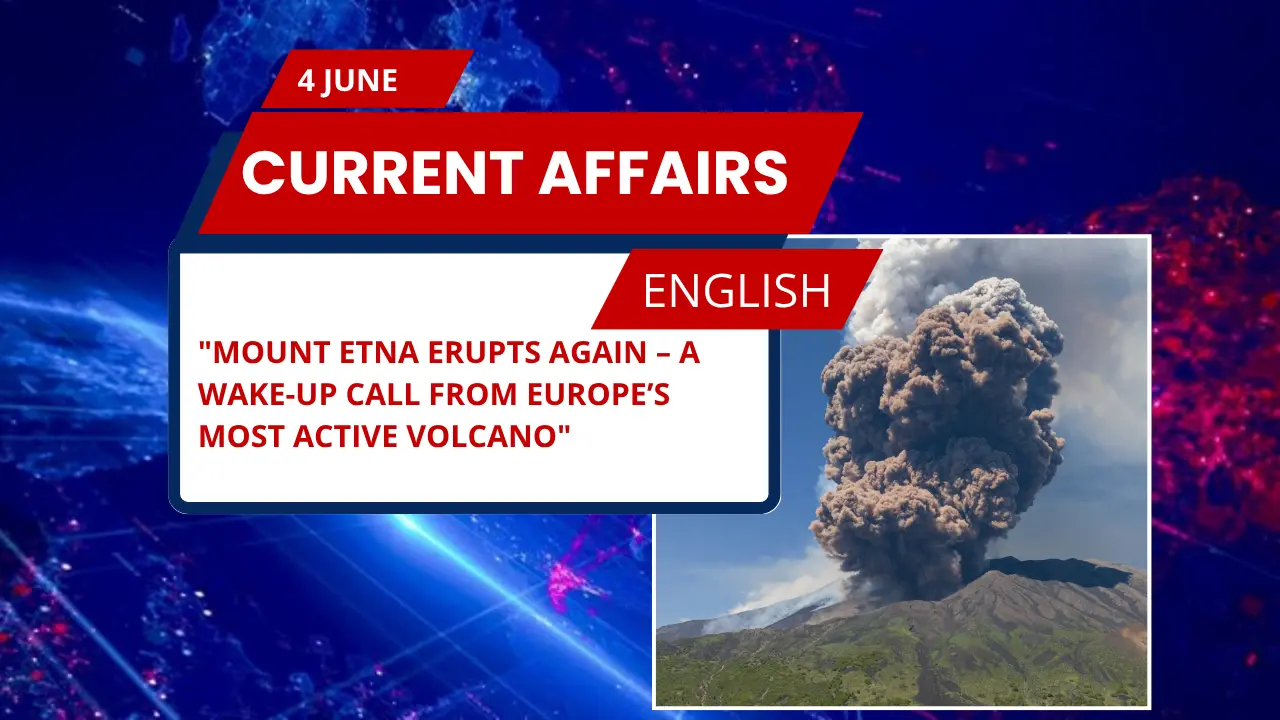
Important Key Points for SSC, UPSC & Other Govt Exams:
- Mount Etna Location: Sicily, Italy
- Date of Latest Eruption: 2nd June 2025
- Type of Volcano: Stratovolcano
- Height: ~3,300 metres
- Historical Eruption Record: Over 2,700 years
- Recent Impact: Ash cloud affected Catania Airport operations
- Monitoring Body: Italy’s National Institute of Geophysics and Volcanology (INGV)
- UNESCO World Heritage Site
- Eruption Styles: Effusive (lava flows) and Strombolian (explosive)
- Most Devastating Eruption: In 1669 – lava reached Catania city
Complete Details on Mount Etna’s 2025 Eruption
What Happened?
Mount Etna, Europe’s most active volcano, erupted again on June 2, 2025, sending a massive ash cloud several kilometres into the sky. Located in Sicily, Italy, this volcano added yet another chapter to its long eruptive history. While no major danger was reported to nearby residents, Catania Airport was temporarily impacted as authorities raised the alert level due to ash dispersal.
Overview of Mount Etna
- Mount Etna is a UNESCO World Heritage Site known for its frequent and powerful eruptions.
- With an elevation of around 3,300 metres, it stands nearly four times taller than the Burj Khalifa.
- It has a documented eruption history of over 2,700 years, making it one of the oldest continuously active volcanoes in human records.
Volcanic Type and Characteristics
- Mount Etna is a Stratovolcano, a type known for its conical structure and viscous lava.
- Stratovolcanoes make up about 60% of all volcanoes on Earth.
- Etna exhibits two eruption styles:
- Effusive eruptions: Characterised by steady lava flows.
- Strombolian eruptions: Involving short bursts of explosive activity.
Past Eruptions and Their Impact
- The earliest recorded eruption of Mount Etna dates back to around 1400 B.C.
- The 1669 eruption is the most historically significant, where lava reached the city of Catania, causing widespread damage.
- The 2024 eruption also disrupted air travel temporarily, similar to the 2025 event.
Monitoring and Safety Measures
- The Italy National Institute of Geophysics and Volcanology (INGV) closely monitors Mount Etna.
- Regular updates on seismic and volcanic activity are provided by INGV.
- The Civil Protection Department has implemented lava diversion methods, including earthen barriers, during eruptions to protect nearby infrastructure.
Future Outlook
Given its history, Mount Etna will likely continue to erupt in the future. Scientists use current and past data to:
- Predict eruptions,
- Improve disaster preparedness, and
- Safeguard both residents and tourists.
About the Location (Italy – For MCQ Background Knowledge)
- Country: Italy
- Capital: Rome
- Currency: Euro (€)
- Official Language: Italian
- Mount Etna’s Region: Sicily
- Catania Airport: Closest major airport affected during eruptions
- Volcano Monitoring Body: INGV (Istituto Nazionale di Geofisica e Vulcanologia)
- Other Major Volcanoes in Italy: Mount Vesuvius, Stromboli
Possible MCQs for Exams
1. Where is Mount Etna located?
a) Greece
b) Spain
c) Italy
d) Turkey
2. What type of volcano is Mount Etna?
a) Shield volcano
b) Cinder cone
c) Stratovolcano
d) Caldera
3. When did Mount Etna last erupt, as per the 2025 record?
a) May 20, 2025
b) June 2, 2025
c) April 10, 2025
d) June 5, 2025
4. Which airport was affected by the 2025 Mount Etna eruption?
a) Milan Malpensa
b) Rome Fiumicino
c) Catania Airport
d) Venice Marco Polo
5. Which organisation monitors Mount Etna’s volcanic activity?
a) WHO
b) INGV (Italy’s National Institute of Geophysics and Volcanology)
c) UNDP
d) NASA






